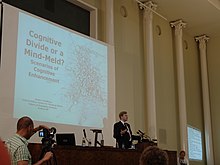
Quick Facts

Biography
Anders Sandberg (born 11 July 1972) is a researcher, science debater, futurist, transhumanist and author.He holds a Ph.D. in computational neuroscience from Stockholm University, and is currently a James Martin Research Fellow at the Future of Humanity Institute at Oxford University.
Work
Sandberg's research centres on societal and ethical issues surrounding human enhancement and new technology, as well as on assessing the capabilities and underlying science of future technologies.His research includes work on cognitive enhancement (methods, impacts, and policy analysis); a technical roadmap on whole brain emulation; on neuroethics; and on global catastrophic risks, particularly on the question of how to take into account the subjective uncertainty in risk estimates of low-likelihood, high-consequence risk.

Sandberg is known as a commentator and participant in the public debate about human enhancement, as well as for his academic publications in neuroscience, ethics, and future studies.

He is co-founder of and writer for the think tank Eudoxa, and is a co-founder of the Orion's Arm collaborative worldbuilding project. Between 1996 and 2000 he was Chairman of the Swedish Transhumanist Association. He was also the scientific producer for the neuroscience exhibition "Se Hjärnan!" ("Behold the Brain!"), organized by Swedish Travelling Exhibitions, the Swedish Research Council and the Knowledge Foundation, that toured Sweden in 2005–2006.In 2007 he was a postdoctoral research fellow at the Uehiro Centre for Practical Ethics at Oxford University, working on the EU-funded ENHANCE project on the ethics of human enhancement.
Sandberg is also an electronic artist, whose renderings have been adapted for book covers by futurist Damien Broderick: The Dreaming, Earth is But a Star, The Judas Mandala, Skiffy and Mimesis, Uncle Bones, Warriors of the Tao, and xyzt.
Sandberg has also supported and advocated cryonics, for example by signing an open letter to support research into cryonics and by being an advisor to the UK Cryonics and Cryopreservation Research Network, a UK advocacy group.
One of his 2014 papers, entitled "Ethics of Brain Emulations", became one of the most downloaded papers in the Journal of Experimental and Theoretical Artificial Intelligence.
With nanotechnologist Eric Drexler and philosopher Toby Ord in 2018 he published a paper entitled "Dissolving the Fermi Paradox". The paper was the first to estimate and rigorously take into account the uncertainties in each term in the Drake equation. These uncertainties, which often span multiple orders of magnitude, can be visualized probability distributions with long tails. Instead of getting a single estimate of the probability of life in our galaxy, they therefore obtained a distribution. They found that there is a high likelihood that we are alone in our galaxy or even alone in the entire observable universe, thus solving the famous Fermi paradox, which asks why we do not see signs of intelligent life in the night sky.
In 2018, in response to a question on Physics Stack Exchange, Sandberg published a paper on arxiv.org entitled "Blueberry Earth", which answered the question "what if the entire Earth was instantaneously replaced with an equal volume of closely packed, but uncompressed blueberries?". The paper got a large amount of news coverage on Slate, The Atlantic, Popular Mechanics, Atlas Obscura, The Chronicle of Higher Education, Forbes, Live Science, Physics World, New Scientist, and many blogs and podcasts.
